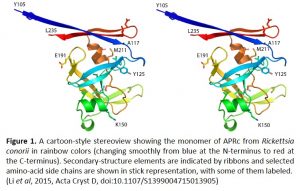- Biochemistry and biology of prokaryotic aspartic proteases (APs) and their role as potential therapeutic targets in pathogenic Bacteria
The relevance of proteolytic events for bacterial pathogenicity has been described for different pathogenic bacteria. Given the lack of effective therapeutics and/or the progressive increase in antimicrobial resistance, the search for alternative therapeutic strategies using proteases as candidate targets for intervention represents a challenging topic for future research. Knowledge of bacterial genomics has brought new opportunities to this field by revealing a new set of putative targets, and a major task for the future rests in the demonstration and characterization of enzymatic activity, properties and function of a vast number of in silico predicted proteases. Strikingly, the presence of APs of both pepsin and retropepsin-type in prokaryotes has always been a matter of debate and our work has provided the first unequivocal documentation of these types of activities in prokaryotes. Recently, we published a pioneer work on the characterization of a membrane-embedded retropepsin-type protease (APRc) highly conserved in Rickettsia (etiologic agents of Rocky Mountain Spotted Fever, Mediterranean Spotted Fever and Epidemic typhus), providing experimental evidences for its activity as a modulator of rickettsial surface antigen/virulence determinants.
Moreover, structural results unequ ivocally demonstrated that the APRc monomer follows the canonical fold observed in all retropepsins, either of viral or eukaryotic origin. These results clearly suggest that APRc may be involved in a relevant proteolytic pathway in the rickettsial life-cycle, likely as a modulator of activity/virulence of other rickettsial membrane-localized proteins.
ivocally demonstrated that the APRc monomer follows the canonical fold observed in all retropepsins, either of viral or eukaryotic origin. These results clearly suggest that APRc may be involved in a relevant proteolytic pathway in the rickettsial life-cycle, likely as a modulator of activity/virulence of other rickettsial membrane-localized proteins.
These findings provide the ground for further exploring APRc as a target for the development of new drugs to combat rickettsioses, as well as for the establishment of an integrated platform that can be used in parallel for the discovery, characterization and evaluation of “targetability” of proteases from other pathogens.
On-going activities in the laboratory include a detailed biochemical, structural and functional characterization of selected prokaryotic pepsin- and retroviral-like enzymes to further understand the structural features, molecular evolution, “targetability” or potential applicability of these ancestral forms of APs.
